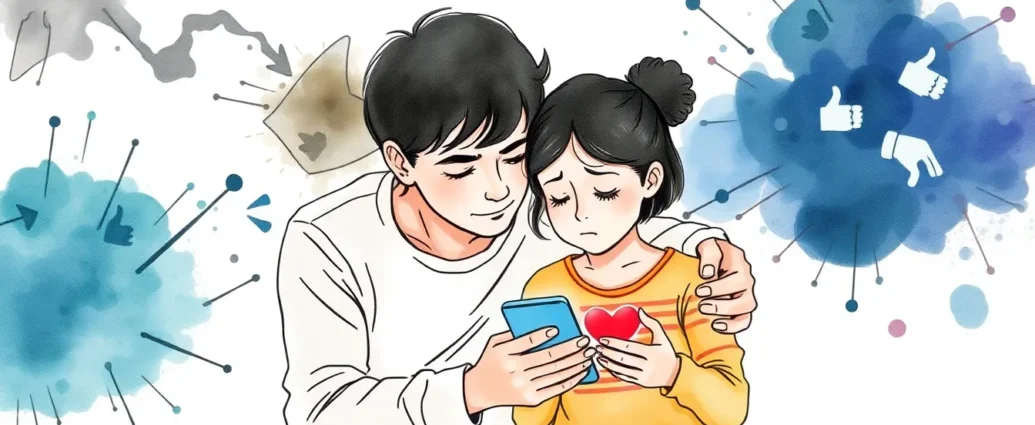Cyberbullying Prevention Guide: Signs, Tips, and Parent Advice
Look, I’ll be straight with you. Last week my neighbor knocked on my door, eyes red from crying, telling me about her daughter’s Instagram nightmare. Apparently some kids from school were posting mean comments on every single photo she shared, and it had been going on for months. The thing is… I realized I had no clue what I’d do if it were my kid.
That conversation got me thinking about how we’re all kind of winging it when it comes to how to prevent cyberbullying. I mean, we didn’t grow up with this stuff. Sure, we had bullies, but they couldn’t follow us home through our phones. Now? Our kids are dealing with a whole different beast.
Actually, scratch that—it’s not totally different. The hurt is the same, maybe even worse because it never stops. But the rules of the game have definitely changed, and honestly, most of us parents are playing catch-up.
What Exactly Is Cyberbullying Anyway?
You know what’s funny? I thought cyberbullying was just mean texts until I started digging deeper. Turns out it’s way more complex than that.
Cyberbullying is basically any repeated harassment that happens through digital devices—phones, tablets, computers, gaming consoles. We’re talking about deliberate, aggressive behavior meant to hurt someone, and it doesn’t stop after one incident. Think mean posts on social media, cruel group chats, embarrassing photos shared without permission, or even creating fake accounts to harass someone.
The thing that really gets me is how it can happen 24/7. Remember when the worst part of your day at school was… well, school? Now kids can get home, close their bedroom door, and still get bombarded with cruelty. There’s literally no escape.
What makes this particularly tricky is that a lot of what happens online would definitely be considered bullying if it happened face-to-face, but somehow when it’s behind a screen, people tend to minimize it. “Just turn off your phone,” they say. But that’s like telling a kid to stop breathing in 2025.
The Warning Signs That Made Me Wake Up
After talking to that neighbor, I started paying closer attention to my own kids. And honestly? I was shocked by what I’d been missing.
The obvious signs are pretty clear—if your kid shows you mean messages or seems upset after being online. But there are so many subtle ones that flew right over my head. Like when my son suddenly stopped wanting to walk to school with his usual group. Or when my daughter, who used to be glued to her phone, started leaving it in another room.
Changes in mood after using devices is huge. If your normally chatty kid becomes withdrawn every time they check their phone, that’s not teenage moodiness—that’s something worth investigating. Same goes for kids who suddenly don’t want to go to school, seem anxious about social events they used to love, or start having trouble sleeping.
Here’s what really opened my eyes: academic performance can tank when kids are dealing with online harassment. It makes total sense when you think about it. If you’re constantly worried about what cruel thing might pop up on your screen next, how are you supposed to focus on algebra?
I also learned that some kids become secretive about their online activity—not because they’re doing anything wrong, but because they’re trying to protect their parents from worrying. Sweet, but not helpful.
Physical symptoms are real too. Headaches, stomachaches, changes in eating habits. Sometimes our kids’ bodies are telling us what their words can’t.
Why Schools Can’t Handle This Alone
Let me tell you something that might make you as frustrated as it made me: schools are trying, but they’re often as confused as we are about handling cyberbullying.
Most schools have anti-bullying policies now, which is great. The problem is that a lot of cyberbullying happens outside school hours, on personal devices, using apps that many teachers have never heard of. So when your kid comes home upset about something that happened on Discord at 9 PM, the school’s response might be limited.
That said, schools aren’t completely powerless. If cyberbullying involves students from the same school and it’s affecting your child’s ability to learn or feel safe at school, they usually have to act. Many states require schools to address cyberbullying even when it happens off-campus if it disrupts the school environment.
The key is communication. I learned this the hard way when I assumed the school knew about an issue that was obviously affecting my kid’s classroom behavior. They didn’t. They can’t read minds, and they can’t monitor every digital interaction between students.
Building a partnership with your child’s school means staying in regular contact, understanding their policies, and being realistic about what they can and can’t control. It also means advocating for better digital citizenship education if your school doesn’t have it.
The Tech Talk That Actually Matters
OK, here’s where I’m going to be real with you. Most of us parents are intimidated by our kids’ tech knowledge. My 12-year-old knows apps I’ve never heard of, and by the time I figure out TikTok, she’s moved on to something else.
But here’s the secret: you don’t need to be a tech genius to help prevent cyberbullying. You just need to be curious and present.
Start by asking your kids to teach you about their favorite apps and platforms. This isn’t about spying—it’s about understanding their world. When you show genuine interest in what they’re doing online, they’re more likely to come to you when something goes wrong.
Learn the privacy settings together. Most platforms have pretty decent tools for controlling who can contact your child, who can see their posts, and how to report problematic behavior. But these settings aren’t always obvious, and they definitely aren’t automatically set to the safest options.
I made it a family activity. We went through each app together, looked at the safety features, and talked about why certain settings matter. It was actually kind of fun, and my kids appreciated that I was trying to understand their world instead of just restricting it.
The goal isn’t to become the tech police. It’s to create an environment where your kids feel comfortable talking to you about their online experiences, both good and bad.
Creating Your Family’s Digital Safety Plan
You know what I wish someone had told me earlier? That preventing cyberbullying isn’t just about restrictions—it’s about creating a family culture around digital respect and safety.
We ended up creating what we call our “digital family contract.” It sounds formal, but it’s really just our agreed-upon guidelines for how we use technology in our house. Things like no phones during family meals, no sharing personal information online, and always asking before downloading new apps.
But the most important part isn’t the rules—it’s the conversations. We talk regularly about what makes someone a good digital citizen, how to respond when someone is mean online, and why it’s never OK to participate in hurting others, even if it seems like just a joke.
I also learned to pay attention to online friend groups and social dynamics. Just like you’d want to know about your kid’s in-person friends, it matters who they’re interacting with online. Not to be controlling, but to be aware of influences and potential problems.
One thing that really helped was establishing “tech-free” times and spaces in our house. It gives everyone a break from the pressure of being constantly connected and creates natural opportunities for face-to-face conversations.
When Cyberbullying Happens: Your Action Plan
Despite your best prevention efforts, cyberbullying might still happen. And when it does, your response in those first crucial moments can make a huge difference.
First things first: stay calm. I know that’s easier said than done, especially if your child shows you something truly awful that someone sent them. But your kid is watching your reaction, and they need to see that you can handle this.
Don’t tell them to just ignore it or to “get off social media for a while.” That’s like telling them to solve the problem by hiding, which isn’t fair and doesn’t work long-term.
Instead, document everything. Take screenshots, save messages, note dates and times. This evidence might be crucial later, whether you’re dealing with schools, parents of other kids, or in extreme cases, law enforcement.
Listen to your child without immediately jumping to solutions. Sometimes they just need to vent and feel heard before they’re ready to problem-solve with you.
Work together to block or report the person doing the bullying. Most platforms have reporting mechanisms, and they’re actually getting better at taking action when behavior violates their community standards.
Involving Schools the Right Way
Remember when I said schools can’t handle cyberbullying alone? Well, that doesn’t mean they can’t be valuable partners.
When you do decide to involve the school, come prepared. Bring your documentation, be specific about how the situation is affecting your child’s school experience, and know what you’re asking for.
Some schools have really good processes for this, others are still figuring it out. If you get pushback about “it didn’t happen on school property,” calmly explain how it’s affecting your child’s education and social environment at school. Most administrators understand this connection once it’s pointed out.
Don’t go in guns blazing, but don’t be a pushover either. You’re advocating for your child’s right to feel safe and focus on learning. That’s not unreasonable.
Ask about restorative justice programs if your school has them. Sometimes bringing together the kids involved in a structured conversation can be more effective than just punishment.
The Mental Health Side Nobody Talks About
This is the part that keeps me up at night sometimes. The psychological impact of cyberbullying can be really serious, and it’s not something that just “builds character” or that kids should have to tough out.
Kids who experience cyberbullying are at higher risk for anxiety, depression, and even suicidal thoughts. That’s not being dramatic—that’s what the research shows. The constant nature of online harassment can make kids feel like there’s no escape, no safe space.
Watch for changes in your child’s behavior, sleep patterns, academic performance, and social relationships. Trust your gut if something seems off.
Don’t hesitate to seek professional help if you’re concerned about your child’s mental health. School counselors can be great resources, but sometimes you need someone outside the school system.
One thing I learned is that kids often blame themselves for cyberbullying. They think they must have done something to deserve it, or they’re embarrassed that they can’t handle it on their own. Reassuring them that it’s not their fault is crucial.
Teaching Kids to Be Upstanders
You know what’s interesting? Most cyberbullying happens with an audience. Other kids see what’s happening, but they don’t know what to do about it.
Teaching our kids to be “upstanders” instead of bystanders is huge. This means empowering them to safely speak up when they see someone being treated badly online.
Sometimes this looks like a private message to the person being bullied, offering support. Sometimes it’s reporting the behavior to the platform or a trusted adult. And sometimes it’s just refusing to participate or share mean content.
We practice scenarios at home. What would you do if you saw someone posting embarrassing photos of a classmate? What if your friend was being mean to someone in a group chat? These conversations help kids think through their options before they’re in the moment.
I also try to reinforce that being popular or fitting in isn’t worth participating in hurting others. It’s a tough message in a world where social status feels like everything to teenagers, but it’s important.
The Role of Social Media Companies
Let’s be honest—tech companies could be doing more to protect kids. But while we’re waiting for better policies and enforcement, we need to work with the tools we have.
Most major platforms have gotten better about providing reporting mechanisms and responding to clear violations of their community standards. But the burden is still largely on users to identify and report problematic behavior.
Learn how to report and block users on the platforms your kids use. Teach your kids how to do this too, and make sure they know it’s OK to block someone who’s making them uncomfortable, even if it’s someone they know in real life.
Privacy settings are your friend. Regularly review who can contact your child, who can see their posts, and what information is publicly visible. These settings change frequently, so this isn’t a one-time conversation.
When to Call in the Big Guns
Sometimes cyberbullying crosses the line from being mean into being illegal. Threats of violence, sharing intimate images without consent, stalking, or harassment based on protected characteristics can all be criminal offenses.
If you believe laws have been broken, document everything and contact law enforcement. Yes, even for online behavior. Police are getting better trained on cybercrime, though experiences vary by location.
This isn’t about being dramatic or overreacting. If someone made credible threats against your child in person, you’d call the police. The same applies online.
Other situations where you might need legal help include cases where schools aren’t responding appropriately to serious cyberbullying, or when the harassment is severe and ongoing despite other interventions.
Building Resilience Without Victim-Blaming
Here’s a tricky balance: we want our kids to be resilient and able to handle difficult situations, but we don’t want to make them feel like being hurt by cyberbullying is their fault or their problem to solve alone.
Building resilience means helping kids develop strong self-esteem, good friendship skills, and healthy coping strategies. Kids who feel confident and connected are often better able to handle adversity when it comes their way.
But resilience doesn’t mean teaching kids to just “toughen up” or ignore cyberbullying. That’s not realistic or fair. Real resilience includes knowing when and how to ask for help.
Encourage your kids to develop interests and friendships offline too. Having a strong sense of identity that isn’t dependent on online validation can be protective.
The Sibling Factor
If you have multiple kids, cyberbullying can affect the whole family dynamic. Sometimes siblings are involved in the same online drama, or one child’s cyberbullying experience creates stress that impacts everyone.
Be careful not to make one child’s cyberbullying experience into a teaching moment for their siblings. Each kid needs individual support and attention.
At the same time, use age-appropriate situations as opportunities to talk about digital kindness and citizenship with all your kids. Just be sensitive about timing and context.
Moving Forward After Cyberbullying
Recovery from cyberbullying isn’t always linear. Some days your kid might seem fine, others they might be really struggling. That’s normal.
Focus on rebuilding their confidence and sense of safety. This might mean taking a break from certain platforms, changing schools, or working with a counselor. Every situation is different.
Help your child reconnect with activities and people that make them feel good about themselves. Sometimes cyberbullying can make kids withdraw from everything, but gentle encouragement to re-engage can be helpful.
Don’t rush the process. Some kids bounce back quickly, others need more time. Follow your child’s lead while continuing to offer support and resources.
The Bigger Picture
Look, cyberbullying isn’t going anywhere. As technology evolves, so do the ways people can hurt each other. But that doesn’t mean we’re powerless.
The goal isn’t to create a perfect bubble around our kids—it’s to give them the tools and support they need to navigate an imperfect world. This includes teaching them to be kind, to seek help when they need it, and to stand up for others when they can.
It also means accepting that we can’t prevent every bad thing from happening to our children. But we can be present, supportive, and proactive about creating safer online environments for everyone.
Quick Takeaways for Busy Parents
- Start conversations about online behavior early, even before kids have their own devices
- Know what platforms your kids use and understand their basic safety features
- Document cyberbullying incidents with screenshots and detailed notes
- Don’t hesitate to involve schools when cyberbullying affects your child’s education
- Take threats seriously and involve law enforcement when laws may have been broken
- Focus on your child’s emotional wellbeing throughout any cyberbullying situation
- Teach kids to be upstanders who safely support others experiencing online harassment
Final Thoughts
Am I overthinking all of this? Maybe. But after watching my neighbor’s family go through that Instagram situation, and seeing how it affected not just her daughter but their whole family dynamic, I’d rather be the parent who’s too prepared than the one caught off guard.
The truth is, most of us are figuring this out as we go. Our kids are the first generation to grow up with smartphones and social media from elementary school, and we’re the first generation of parents trying to guide them through it.
What gives me hope is seeing how resilient kids can be when they have support, and how quickly things can improve when adults take cyberbullying seriously and respond appropriately.
We might not be able to completely prevent cyberbullying, but we can definitely minimize its impact and help our kids develop the skills they need to handle whatever the online world throws at them.
That neighbor I mentioned? Her daughter is doing much better now. It took some time, some difficult conversations with the school, and yes, a temporary break from Instagram. But she learned that she could handle hard things, and more importantly, that she didn’t have to handle them alone.
Isn’t that what we all want for our kids?



